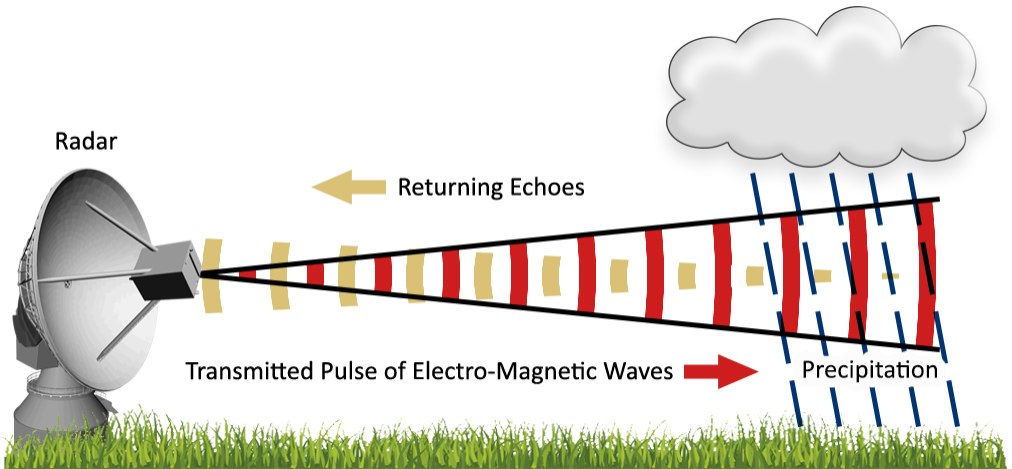Installation of X-Band Radar | 18 Oct 2024
Why in News?
Recently, the Ministry of Earth Sciences approved an X-band radar to be installed in Kerala’s Wayanad district after devastating floods and landslides.
What are Key Facts About X-Band Radars?
- About Radar: Radar is a device that uses radio waves to detect and locate objects by measuring the reflection of the waves.
- Radar stands for radio detection and ranging.
- Working of Radar: The radar device comprises a transmitter that emits a signal aimed at an object whose characteristics are to be ascertained (e.g., cloud in meteorology).
- A part of the emitted signal is echoed by the object back to the device, where a receiver tracks and analyses it.
- Applications in Meteorology: Doppler radars (weather radar) reveal how fast a cloud is moving and in which direction based on the cloud’s relative motion changes the frequency of the radiation striking it.
- A Pulse-Doppler radar can measure the intensity of rainfall by emitting radiation in pulses and tracking how often they’re reflected to the receiver.
- Doppler effect is the change in frequency of sound waves as their source moves towards and away from a listener.
- Doppler radars rely on Rayleigh scattering in which light or other electromagnetic radiation is scattered by particles much smaller than the wavelength of the light.
- Modern Doppler radars can monitor weather conditions and anticipate new wind patterns, the formation of storms, etc.
- X-Band Radar: An X-band radar is radar that emits radiation in the X-band of the electromagnetic spectrum (8-12 GHz) corresponding to wavelengths of around 2-4 cm (this is in the microwave part of the spectrum.)
- It uses radiation of lower wavelengths to observe smaller particles like rain droplets or fog.
- The smaller wavelengths allow the radar to produce images of higher resolution but X-band radars have a relatively shorter range.
- Role of X-Band Radar in Wayanad: It will monitor soil particle movements, assisting in the issuance of landslide warnings.
- It will conduct high temporal sampling, allowing for rapid detection of changes in particle movement over brief periods.
How many radars does India have?
- Historical Context: The India Meteorological Department (IMD) began using radar for weather in the early 1950s.
- In 1970, it installed the first indigenously designed X-band storm detection radar in New Delhi. By 1996, IMD upgraded 10 outdated X-band radars to digital versions.
- Types of Radar Network: In its X-band radar network, India has both wind-finding and storm-detecting radars, and some with dual capabilities.
- India also uses S-band radars (2-4 GHz) for long-range detection.
- The first S-band cyclone detection radar was installed in Visakhapatnam in 1970 and the first locally made variant was commissioned in Mumbai in 1980.
- Recent Initiatives: As of September 2024, India plans to install 56 additional Doppler radars, part of the Rs 2,000-crore Mission Mausam initiative aimed at enhancing meteorological infrastructure by 2026.
- The government is also in the process of acquiring and installing 10 X-band Doppler radars in northeastern states and Himachal Pradesh’s Lahaul and Spiti district.
- A C-band radar (4-8 GHz) with an observational range of 250 km will be installed in Mangaluru.
UPSC Civil Services Examination, Previous Year Question (PYQ)
Prelims:
Q.Consider the following phenomena: (2013)
- Size of the sun at dusk
- Colour of the sun at dawn
- Moon being visible at dawn
- Twinkle of stars in the sky
- Polestar being visible in the sky
Which of the above are optical illusions?
(a) 1, 2 and 3
(b) 3, 4 and 5
(c) 1, 2 and 4
(d) 2, 3 and 5
Ans: (c)

